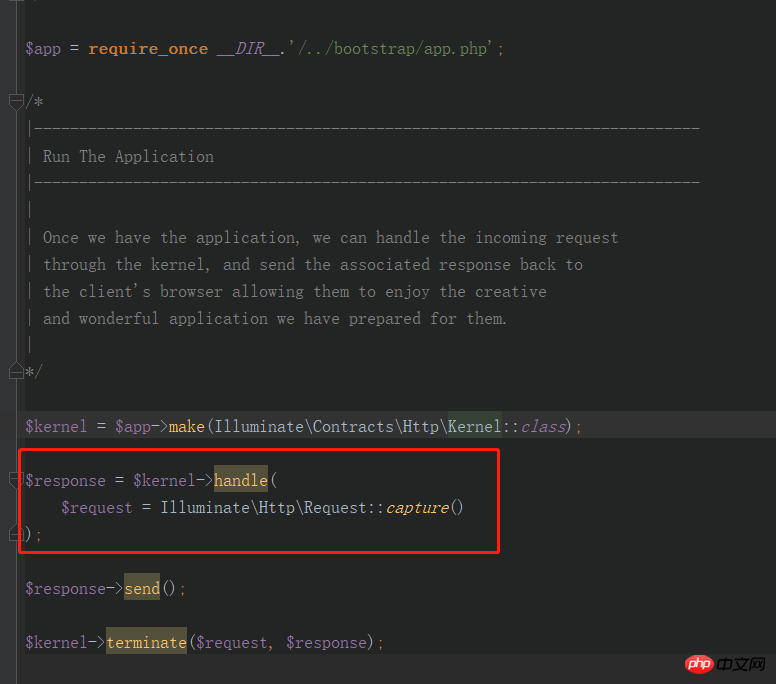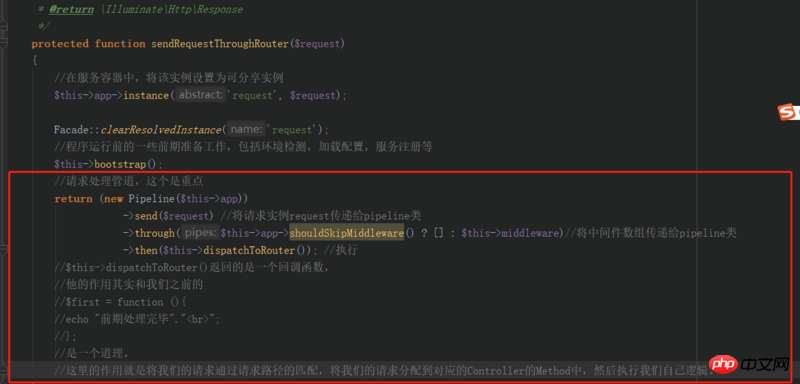本篇文章給大家帶來的內容是關于laravel框架的中間件middleware的詳解,有一定的參考價值,有需要的朋友可以參考一下,希望對你有所幫助。
laravel中間件是個非常方便的東西,能將一些邏輯實現解耦,并且在laravel中,
中間件的編寫也是非常的方便。誰用誰知道。
1.裝飾器模式
laravel中的中間件使用的就是裝飾器模式,什么是[裝飾器模式][1],先去了解一下吧,這里大概說一下,就是這個模式主要的就是用于解決?當一個類需要動態擴展功能的時候,使用繼承的方式會讓子類膨脹,并且這個擴展的功能是個公用功能的情況下,不利于功能的復用以及代碼的解耦。
在laravel,使用對于使用這種模式的功能,稱為請求處理管道,也就是pipeline
//公共接口 interface middleware { public static function handle(Closure $next); } //裝飾器1 class MiddleStepOne implements middleware{ public static function handle(Closure $next) { echo "前期處理的第一步"."<br>"; $next(); echo "后期處理的第一步"."<br>"; } } //裝飾器2 class MiddleStepTwo implements middleware{ public static function handle(Closure $next) { echo "前期處理的第二步"."<br>"; $next(); echo "后期處理的第二步"."<br>"; } } function goFunc() { return function ($step,$className) { return function () use ($step,$className) { return $className::handle($step); }; }; } $pip = array( MiddleStepOne::class, MiddleStepTwo::class, ); $pip = array_reverse($pip); //反轉數組,以求達到要求的順序運行 $first = function (){ echo "前期處理完畢"."<br>"; }; //實際要處理的函數 $a = array_reduce($pip,goFunc(),$first); //遍歷pip數組,并將first作為第一個參數傳遞進去 $a(); //執行
輸出:

這個就是一個簡單的基于裝飾器模式的管道。他的本質其實就是基于閉包和遞歸。
通過分析這個程序,對于最終生成的$a變量,它的值大概是這樣的 MiddleStepOne.handle(MiddleStepTwo.handle(first)),當執行的時候因為在handle中有個next()函數的存在,所以這是一個遞歸的調用。對于laravel的中間件,他的實現原理也是和這個一樣的。
2.laravel中的中間件和請求處理管道
在laravel中,我們我們可以通過設置中間件來在請求執行之前做一些預先的處理。
從請求入口?public/index.php開始

重要的是這段代碼:即 處理請求,返回請求的響應
$response = $kernel->handle( $request = IlluminateHttpRequest::capture() //創建一個請求實例 );
接著我們進入kernel中看他的具體實現 IlluminateFoundationHttpKernel.php中


關于dispatchToRouter()函數請大家自己去看,這里就不多說了。
接下來就是激動人心的PipeLine類了,
<?php namespace IlluminatePipeline; use Closure; use RuntimeException; use IlluminateContractsContainerContainer; use IlluminateContractsPipelinePipeline as PipelineContract; class Pipeline implements PipelineContract { /** * The container implementation. * * @var IlluminateContractsContainerContainer */ protected $container; /** * The object being passed through the pipeline. * * @var mixed */ protected $passable; /** * The array of class pipes. * * @var array */ protected $pipes = []; /** * The method to call on each pipe. * * @var string */ protected $method = 'handle'; /** * Create a new class instance. * * @param IlluminateContractsContainerContainer|null $container * @return void */ public function __construct(Container $container = null) { $this->container = $container; } /** * Set the object being sent through the pipeline. * * @param mixed $passable * @return $this */ public function send($passable) { $this->passable = $passable; return $this; } /** * Set the array of pipes. * * @param array|mixed $pipes * @return $this */ public function through($pipes) { $this->pipes = is_array($pipes) ? $pipes : func_get_args(); return $this; } /** * Set the method to call on the pipes. * * @param string $method * @return $this */ public function via($method) { $this->method = $method; return $this; } /** * Run the pipeline with a final destination callback. * * @param Closure $destination * @return mixed */ public function then(Closure $destination) { $pipeline = array_reduce( array_reverse($this->pipes), $this->carry(), $this->prepareDestination($destination) ); return $pipeline($this->passable); } /** * Get the final piece of the Closure onion. * * @param Closure $destination * @return Closure */ protected function prepareDestination(Closure $destination) { return function ($passable) use ($destination) { return $destination($passable); }; } /** * Get a Closure that represents a slice of the application onion. * * @return Closure */ protected function carry() { return function ($stack, $pipe) { return function ($passable) use ($stack, $pipe) { if (is_callable($pipe)) { // If the pipe is an instance of a Closure, we will just call it directly but // otherwise we'll resolve the pipes out of the container and call it with // the appropriate method and arguments, returning the results back out. //如果pip也就中間件函數是一個閉包可調用函數,就直接返回這個閉包函數就行了 //這里我還沒有找到對應的使用場景,后續補充 return $pipe($passable, $stack); } elseif (! is_object($pipe)) { list($name, $parameters) = $this->parsePipeString($pipe); // If the pipe is a string we will parse the string and resolve the class out // of the dependency injection container. We can then build a callable and // execute the pipe function giving in the parameters that are required. $pipe = $this->getContainer()->make($name); $parameters = array_merge([$passable, $stack], $parameters); } else { // If the pipe is already an object we'll just make a callable and pass it to // the pipe as-is. There is no need to do any extra parsing and formatting // since the object we're given was already a fully instantiated object. $parameters = [$passable, $stack]; } return method_exists($pipe, $this->method) ? $pipe->{$this->method}(...$parameters) : $pipe(...$parameters); }; }; } /** * Parse full pipe string to get name and parameters. * * @param string $pipe * @return array */ protected function parsePipeString($pipe) { list($name, $parameters) = array_pad(explode(':', $pipe, 2), 2, []); if (is_string($parameters)) { $parameters = explode(',', $parameters); } return [$name, $parameters]; } /** * Get the container instance. * * @return IlluminateContractsContainerContainer * @throws RuntimeException */ protected function getContainer() { if (! $this->container) { throw new RuntimeException('A container instance has not been passed to the Pipeline.'); } return $this->container; } }
總的來說pipeLine類的實現和我之前寫的修飾器是差不多,這里主要麻煩的地方就在于就在于
protected?function?carry()函數內部,對于當pip是閉包,字符串,還有對象的處理。
之前覺得laravel的中間件是個很神秘的東西,但是看了之后才覺得也就那樣,很精巧,在實際開發中這種模式也是很有幫助的,例如我們目前用的一個gateway項目,因為沒有使用任何框架,所以將判斷條件剝離,寫入到中間件中, 這樣實現了一定程度上的模塊化編程。



















